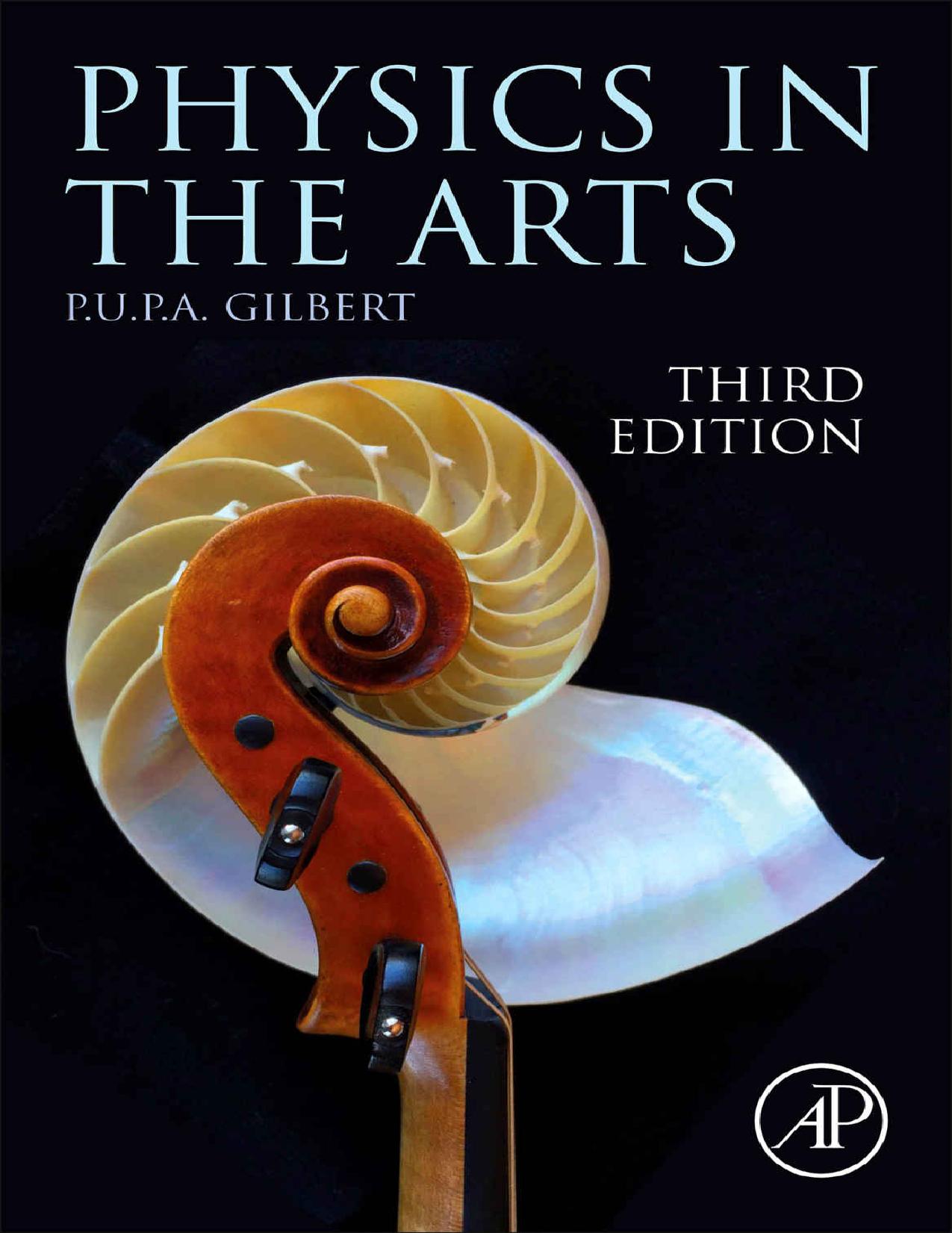Physics in the Arts 3rd Edition by Pupa UPA Gilbert ISBN 0128243481 9780128243480
$70.00 Original price was: $70.00.$35.00Current price is: $35.00.
Instant download Physics in the Arts Pupa U. P. A. Gilbert after payment
Physics in the Arts 3rd Edition by – Ebook PDF Instant Download/Delivery: 0128243481, 9780128243480
Full download Physics in the Arts 3rd Edition after payment

Product details:
ISBN 10: 0128243481
ISBN 13: 9780128243480
Author:
Physics in the Arts, Third Edition gives science enthusiasts and liberal arts students an engaging, accessible exploration of physical phenomena, particularly with regard to sound and light. This book offers an alternative route to science literacy for those interested in the arts, music and photography. Suitable for a typical course on sound and light for non-science majors, Gilbert and Haeberli’s trusted text covers the nature of sound and sound perception as well as important concepts and topics such as light and light waves, reflection and refraction, lenses, the eye and the ear, photography, color and color vision, and additive and subtractive color mixing.
Additional sections cover color generating mechanisms, periodic oscillations, simple harmonic motion, damped oscillations and resonance, vibration of strings, Fourier analysis, musical scales and musical instruments.
- Winner of a 2022 Textbook Excellence Award (College) (Texty) from the Textbook and Academic Authors Association
- Offers an alternative route to science literacy for those interested in the visual arts, music and photography
- Includes a new and unique quantitative encoding approach to color vision, additive and subtractive color mixing, a section on a simplified approach to quantitative digital photography, how the ear-brain system works as a Fourier analyzer, and updated and expanded exercises and solutions
- Provides a wealth of student resources including in-text solutions and online materials including demo and lecture videos, practice problems, and other useful files: https://www.elsevier.com/books-and-journals/book-companion/9780128243473
- Supplies teaching materials for qualified instructors, including chapter image banks, model homework sets, and model exams: ttps://educate.elsevier.com/book/details/9780128243473
Physics in the Arts 3rd Table of contents:
Chapter 1. Light and light waves
1.1. Dual nature of light
1.2. Speed of light
1.3. Electromagnetic spectrum
1.4. Polarization
1.5. Polarizers
1.6. Large and small numbers
Chapter 2. Reflection and refraction
2.1. Specular reflection of light
2.2. Refraction of light
2.3. Total internal reflection
2.4. Due to refraction, things are not where they appear
2.5. Reflection and refraction in diamonds
2.6. Rainbows
2.7. Interesting brightening and darkening effects
2.8. Questions
Chapter 3. Lenses
3.1. Refraction by a prism
3.2. Converging and diverging lenses
3.3. Focal length
3.4. Real and virtual images
3.5. Three easy rays
3.6. The thin lens formula
3.7. More on converging and diverging lenses
3.8. Lens aberrations
3.9. Lenses in art
3.10. Questions
Chapter 4. The human eye
4.1. Components of the human eye
4.2. Accommodation
4.3. Eyeglasses
4.4. Nearsighted eye
4.5. Farsighted eye
4.6. Astigmatic eye
4.7. Presbyopia and multifocal lenses
4.8. Contact lenses and eye surgery
Chapter 5. Photography
5.1. The camera
5.2. Focusing the camera
5.3. Taking a photo: exposure time, f number, and ISO
5.4. Shutters
5.5. Exposure time of shutter speed
5.6. Aperture and f number
5.7. The sensor and its ISO
5.8. Putting it all together: taking a photograph
5.9. Fun photographic facts
5.10. Questions
Chapter 6. Color and color vision
6.1. Physical and perceived color
6.2. Sensitivity curves of cones
6.3. Complementary colors
6.4. Mixed and spectral colors
6.5. Definition of color: hue, saturation, brightness
6.6. The perceived brightness depends on the surroundings
6.7. All colors in the spectrum simplified to RGB
6.8. Why is the sky blue, the sunset red, and a lemon yellow?
6.9. Color blindness
6.10. Color seen by other animals
6.11. Color adaptations
6.12. Questions
Chapter 7. Additive color mixing
7.1. Mixing lights
7.2. Primary colors
7.3. Adding primary colors
7.4. The color triangle
7.5. Low-brightness colors
7.6. Spectral colors
7.7. Nonspectral colors
7.8. Complementary colors on the color triangle
7.9. Additive color mixing in painting
7.10. Questions
Chapter 8. Subtractive color mixing
8.1. Spectra
8.2. Filters and transmission
8.3. Paints and scattering
8.4. Subtractive primary colors
8.5. Blue and yellow may or may not make green
8.6. Multiple scattering
8.7. Spectra, computers, and the color triangle
8.8. Change in hue
8.9. Mixing unequal amounts of paint
8.10. Using a computer to mix paints to obtain any color you wish
8.11. Celestial sleuthing
8.12. Questions
Chapter 9. Color-generating mechanisms
9.1. Illuminating light
9.2. Pigments in animals and plants
9.3. Structural color in animals: iridescence
9.4. More iridescent color-generating mechanisms
9.5. Color in gemstones
9.6. Mineral color due to charge transfer
9.7. Mineral color due to color centers
9.8. Color in gems due to band gap absorption of light
Chapter 10. Sound waves
10.1. Mechanical waves
10.2. Propagation of a pulse
10.3. Longitudinal and transverse waves
10.4. Sound waves in air are longitudinal waves
10.5. Frequency
10.6. Speed of sound in air
10.7. Wavelength and frequency
10.8. Relevance to the size of instruments and loudspeakers
10.9. Sound propagation
10.10. Concert Hall acoustics
10.11. Questions
Chapter 11. Simple harmonic motion
11.1. Definition of simple harmonic motion
11.2. Various simple harmonic oscillators
11.3. Hooke’s law
11.4. Pendulum
11.5. Mass on a spring
11.6. Frequency of oscillation
11.7. Anharmonic oscillators
11.8. Waveform of simple harmonic oscillators
11.9. Phase angle
11.10. Other nonsimple, harmonic oscillators
11.11. Questions
Chapter 12. Damping and resonance
12.1. Damped oscillations, damping time
12.2. Resonance
12.3. Build-up and decay of musical notes
12.4. Resonators in musical instruments and speakers
12.5. Questions
Chapter 13. Vibration of strings
13.1. Pulse on a string
13.2. The first, fundamental mode
13.3. Higher modes
13.4. Traveling versus standing waves
13.5. The voicing formula
13.6. How modes relate to music: partials
13.7. Damping of higher partials
13.8. Plucked strings: missing partials
13.9. Playing harmonics
13.10. Real strings are stiff
13.11. Guitar, violin, harp, and piano strings
13.12. Questions
Chapter 14. Waves in pipes
14.1. Pressure pulse in a pipe
14.2. Open and closed pipes, boundary conditions
14.3. Acoustic length
14.4. Standing waves in open pipes
14.5. Fundamental frequency of open pipe
14.6. Higher modes of open pipe
14.7. Fundamental frequency of closed pipe
14.8. Higher modes of closed pipe
14.9. Playing tunes on wind instruments: fingerholes and overblowing
14.10. Other shapes
14.11. Questions
Chapter 15. Superposition, beats, and harmony
15.1. Superposition of sound waves, phase, interference
15.2. Principle of superposition
15.3. Two pure tones of the same frequency, phase shift as an angle
15.4. Beats
15.5. Harmony
15.6. Phase changes the waveform, not the sound
15.7. Just for fun: lissajous figures
15.8. Questions
Chapter 16. Musical scales
16.1. The need for musical scales
16.2. Musical intervals
16.3. Harmony and small number ratios
16.4. The major triad
16.5. Constructing the just scale
16.6. Names of intervals
16.7. Whole-tone and semitone intervals
16.8. Transposing: why black keys?
16.9. The problems with the just scale
16.10. Perfection sacrificed: the tempered scale
16.11. Major and minor scales
16.12. The natural scale
16.13. Questions
Chapter 17. Fourier analysis
17.1. Fourier’s theorem
17.2. Fourier spectra
17.3. Fourier analyzer
17.4. Fourier synthesis
17.5. Why can’t you synthesize a Stradivari?
17.6. Questions
Chapter 18. Musical instruments
18.1. The structure of musical instruments
18.2. Excitation mechanism
18.3. Playing a tune
18.4. Strings
18.5. Woodwinds
18.6. Brass instruments
18.7. Percussion instruments
18.8. Voice
18.9. Questions
Chapter 19. Sound perception: Timbre, loudness, and pitch
19.1. Timbre and Fourier spectrum
19.2. Loudness, amplitude, volume, sound intensity level, and decibels
19.3. Loudness also depends on frequency
19.4. Pitch and frequency
Chapter 20. The ear
20.1. The outer ear
20.2. The middle ear
20.3. The inner ear
20.4. Amplitude and loudness
20.5. Frequency, period, and sequence of nerve pulses sent to the brain
Chapter 21. Solutions to all questions
Chapter 22. Formulae, constants, and useful physical data
People also search for Physics in the Arts 3rd:
pupa gilbert physics in the arts
physics in entertainment and the arts kent state
physics in arts and sports
physics arts and crafts
physics art and math


